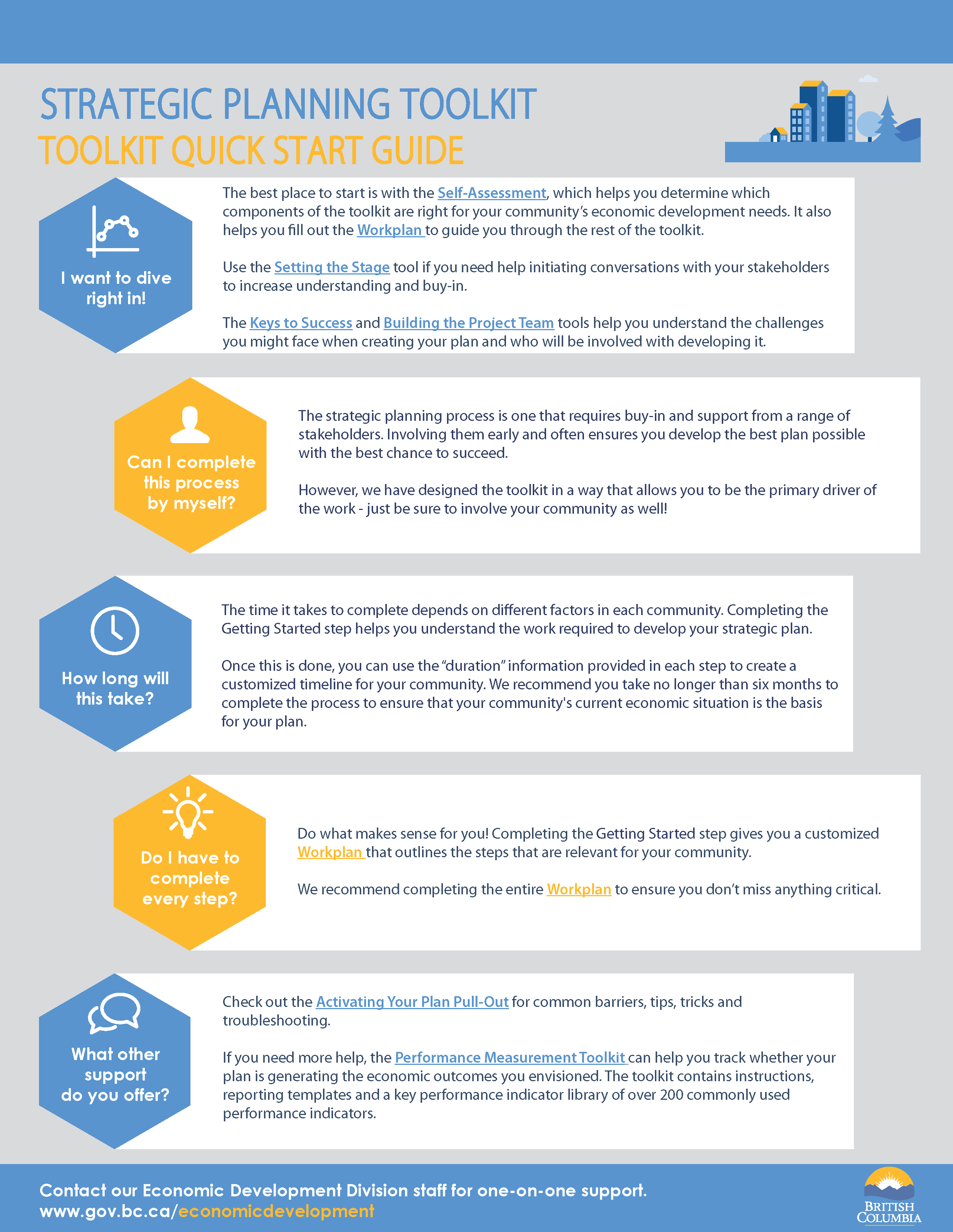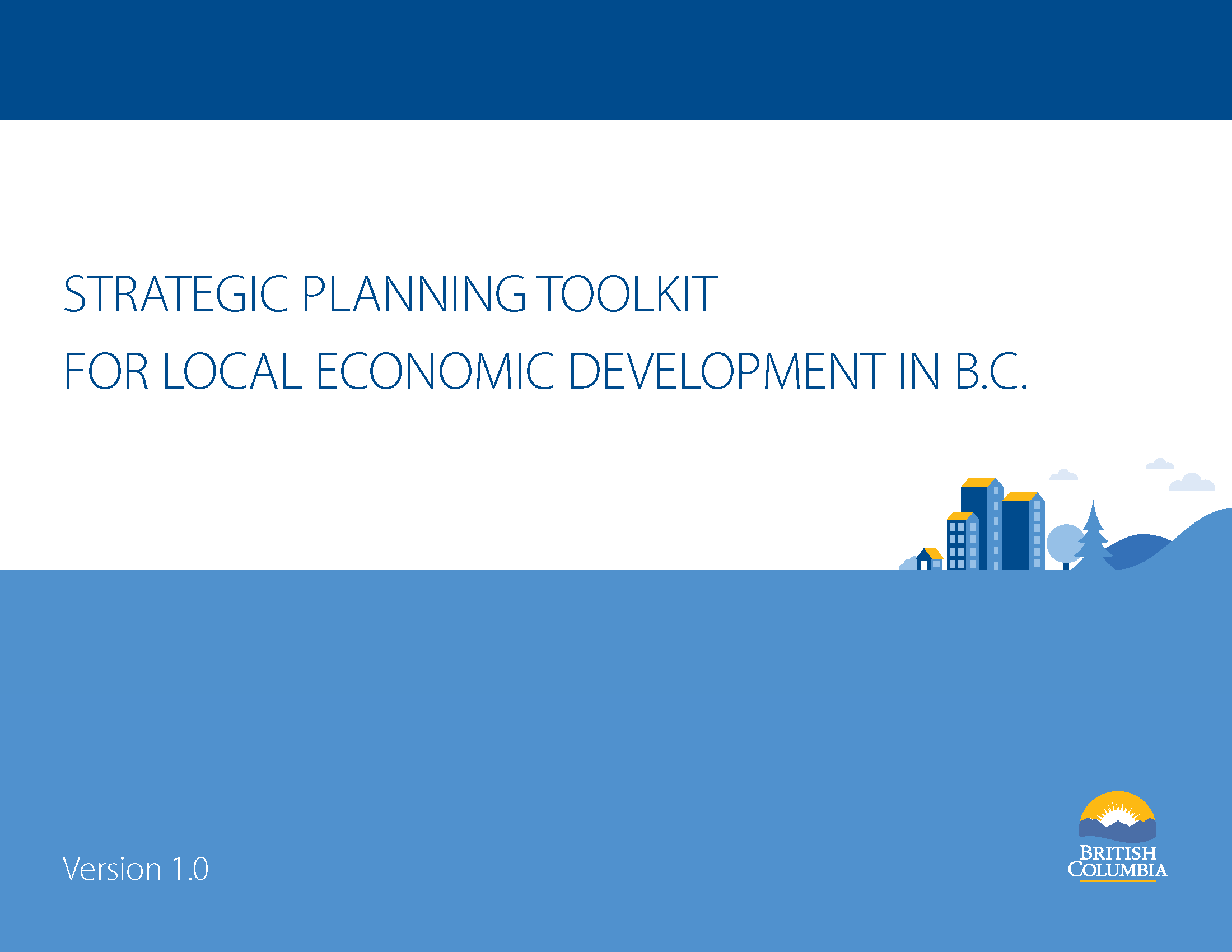Strategic Planning Toolkit for Local Economic Development
The Strategic Planning toolkit allows you to quickly and effectively develop a customized action plan to realize your community’s economic vision. Whatever your stage in the planning process, capacity or community size, the toolkit can work for you.
It can help communities who:
- Have never developed, or have an outdated strategic plan
- Have a lengthy plan that was created, but has sat on the shelf
- Have an active plan but need implementation, monitoring or measurement support
- Aren't able to go through a whole planning process but would benefit from learning about individual components of the process
How the Strategic Planning Toolkit Works
Click below to access the tools and templates for each step of the planning process. Begin at the “Getting Started” step.
Laying a solid foundation ensures that your consultation, planning and implementation occur with minimal hiccups. Go through the following stages to make sure you have a strong foundation in place.
- Start with the self-assessment which is the key to the process. It provides an overview of the various tools and templates available, allowing you to determine which components are right for your situation. Access those relevant to your customized process.
- Setting the stage provides guidance on why strategic planning is a good idea, and initiates early conversations with key players that will generate important feedback and support.
- Keys to success tool: Sometimes challenges exist that impede the strategic planning process. Use this simple tool to anticipate issues and ensure that it’s the right time for strategic planning.
- Building the project team: It’s vital to have the right people on board to steer the process. Before proceeding, establish your committee or project team that will be involved at every stage. Template: Terms of reference
- Workplan: From the self-assessment, you can easily organize your customized process into a high-level customized workplan that will guide the planning stages.
2. Where are we now?
Before deciding which road to follow, it’s a good idea to know which direction you’re facing. Strategic planning is no different: start by gaining an understanding of your community and its current context.
- Info and asset inventory: Taking stock of your current context allows for better planning. This tool helps you gather information and list the assets you have available to you. Capture it all in an at-a-glance key facts template that you can refer to throughout your planning process.
- Stakeholder and partner identification is an important step in making sure that you include all relevant perspectives in the planning process, while stakeholder and partner engagement helps you create a specific plan to integrate these groups or people into the process. Consult the stakeholder pull-out for additional tips.
- Strategic assessment: This cornerstone of strategic planning assists you in identifying the strengths, challenges and opportunities facing your community.
3. Where do we want to go?
This is where the planning begins in earnest, based on your early consultations and brainstorming.
- Visioning helps you set a big picture goalpost. It ensures everyone is on the same page with what you’re ultimately striving for, and helps you choose the activities that will get you there.
- Identifying strategic areas starts to narrow the focus and determine the broader types of economic development efforts that will be undertaken. Setting strategic area goals for these areas helps to establish “mini visions” that will direct and hone your potential activities.
4. How are we going to get there?
After defining your vision and goals, choose specific activities to reach those goals and develop your implementation plan.
- Translate strategic areas into action by brainstorming activities related to each area, then prioritize them to focus on those that are most attainable and have the greatest benefit.
- Then, pull it all together in a brief and easy-to-read format using the strategic plan template and the at-a-glance plan-on-a-page.
- Finally, keep the momentum going by developing a simple implementation plan to make sure that you stay on track and everyone knows what their roles are. Consult the activating your plan pull-out for implementation tips, tricks and troubleshooting.
5. Are we getting there?
Keeping track of your activities and progress through monitoring, measurement and evaluation is a very important aspect of your plan. Done well, tracking progress and staying flexible ensures that your efforts are targeted, streamlined and high-impact.
- Monitoring refers to tracking your activities, which has been built into the implementation plan.
- Performance measurement looks at how your activities are helping you meet your goals. It’s a vital step in making sure your efforts are on track, that you’re staying accountable, and making course-corrections as you go along. It’s usually based on regular data-gathering.
- Evaluation helps with this as well, looking more inwardly at whether your strategic areas and goals are still relevant and working well for your stakeholders. It’s typically done in the middle and/or at the end of the strategic process and is based on consultation.


Regional Economic Operations (REO) staff are located in every region of the province. They assist communities in planning and implementing economic development priorities.
Check out this useful Quick Start Guide to help you get up and running successfully.
Download the complete toolkit (PDF, 3.6 MB)
B.C. Assembly of First Nations (BCAFN) works with First Nations to provide them with the tools and information they need to build successful, sustainable plans for economic development.



